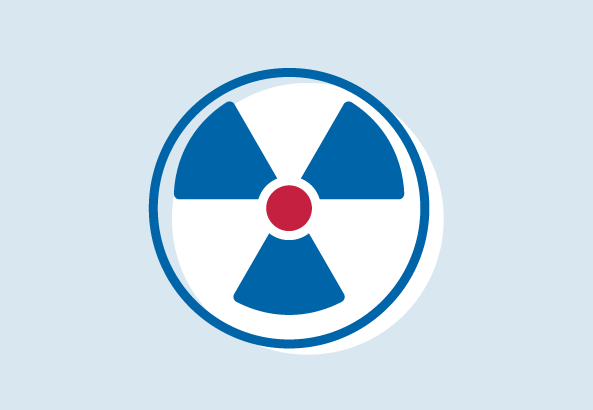

Radiotherapy plays an important role in the treatment of malignant diseases: 30–50% of all cancer patients receive radiotherapy either alone or with chemotherapy and surgery during the course of their treatment.1 While medications taken as tablets or administered through infusion have an effect throughout the body (systemic), radiotherapy targets a specific area of radiation (local).2
Radiotherapy is sometimes combined with drug treatment, such as chemotherapy.2

Radiotherapy destroys cancer cells using ionizing radiation, which damages the genetic material (DNA; deoxyribonucleic acid) of the cells. This prevents the cells from dividing, causing them to die.1 Depending on the treatment goal, radiotherapy can either shrink the tumour (palliative intent) or make it disappear completely (curative intent).2
Radiotherapy not only affects cancer cells, but also affects healthy cells in the body. However, healthy cells can repair themselves much easier than tumour cells.2 To give the healthy cells enough time for repair processes, treatment is usually spread out over a few weeks (fractions).2

Different forms of radiotherapy are used depending on the type of tumour. Radiation can be delivered externally (from outside the body) or internally (with a radiation source placed near the tumour).1,2 In lymphoma, radiotherapy often targets specific groups of lymph nodes.3
For most lymphoma treatments, radiotherapy is delivered externally (percutaneously) with a focused beam of high-energy X-rays (photons) from a machine called a linear accelerator.2,4 Patients lie on a specialised couch during the procedure.2 The treatment may target a limited area of the body or, in some cases, the entire body, depending on the disease and treatment goals.2
In early-stage follicular lymphoma, radiotherapy is an effective method for treating affected lymph-node regions . Doctors often combine radiotherapy with drug treatment for follicular lymphoma.5
Radiotherapy is also an important treatment to prepare for a stem cell transplant to destroy all diseased cells in the bone marrow before the new, healthy cells are implanted. In this case, it is carried out as total-body irradiation.2,6
Recent technological advances have made radiotherapy more precise, reducing the damage to surrounding healthy tissue. Additionally, a better understanding of how radiotherapy interacts with tumours and healthy cells has improved the effectiveness of the treatment.7 However, side effects cannot be completely avoided. The side effects you experience will depend on the type and location of the tumour and the dose and type of radiation administered.2
There are two types of side effects:
References: